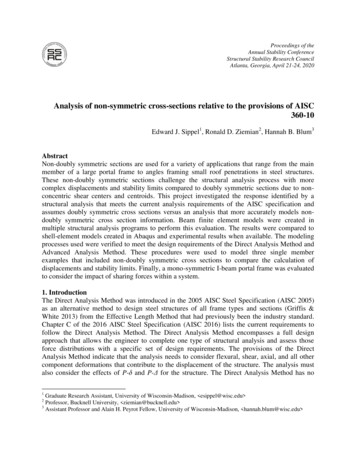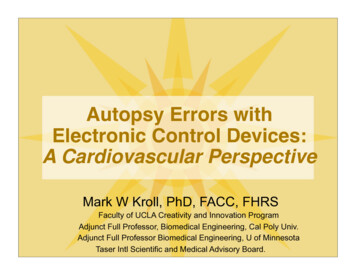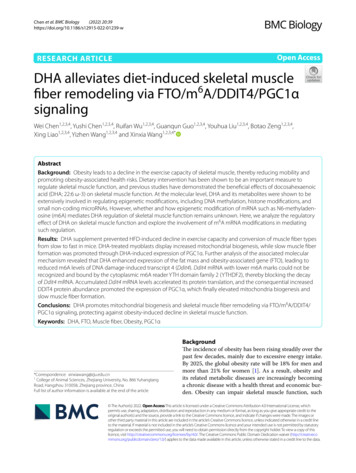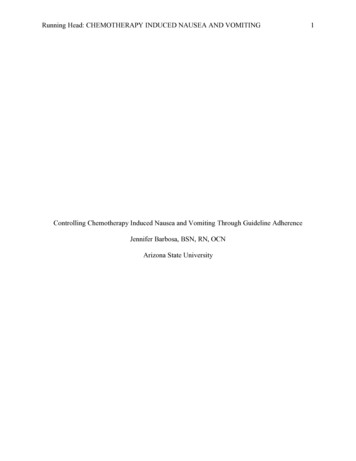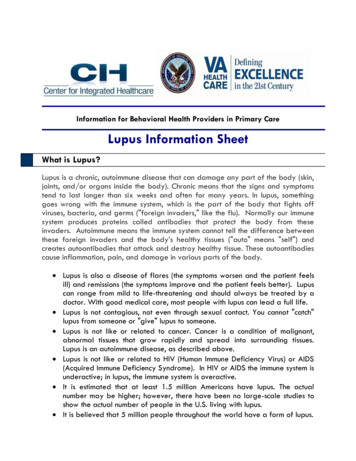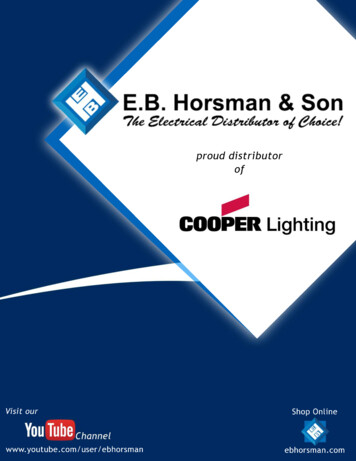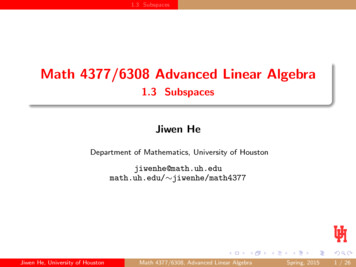
Transcription
Photonics 2015, 2, 308-316; doi:10.3390/photonics2010308OPEN ACCESSphotonicsISSN tromagnetically Induced Transparency in SymmetricPlanar Metamaterial at THz WavelengthsAbdelwaheb Ourir 1,*, Bruno Gallas 2, Loic Becerra 2, Julien de Rosny 1 andPierre Richard Dahoo 3123Laboratoire Ondes et Acoustique (LOA), Institut Langevin, ESPCI ParisTech, UMR 7587, CNRS,1 rue Jussieu, Paris 75005, France; E-Mail: julien.derosny@espci.frInstitut des NanoSciences de Paris, UMR 7588, CNRS-UPMC, 4 place Jussieu, 75252 Paris cedex 05,France; E-Mails: bruno.gallas@insp.jussieu.fr (B.G.); loic.becerra@insp.jussieu.fr (L.B.)LATMOS, Universitéde Versailles-Saint-Quentin-en-Yvelines, CNRS-UPMC-UVSQ (UMR8190), Guyancourt 78280, France; E-Mail: Pierre-Richard.Dahoo@latmos.ipsl.fr* Author to whom correspondence should be addressed; E-Mail: a.ourir@espci.fr;Tel.: 33-1-80-96-30-39.Received: 18 February 2015 / Accepted: 4 March 2015 / Published: 19 March 2015Abstract: We report the experimental observation and the evidence of the analogue ofelectromagnetically-induced transparency (EIT) in a symmetric planar metamaterial. Thiseffect has been obtained in the THz range thanks to a destructive Fano-interferencebetween the two first modes of an array of multi-gap split ring resonators deposited on asilicon substrate. This structure is a planar thin film material with four-fold symmetry.Thanks to this property, a polarization-independent transmission has been achieved. Theproposed metamaterial is well adapted to variety of slow-light applications in the infraredand optical range.Keywords: metamaterial; induced transparency; slow light; infrared1. IntroductionElectromagnetically induced transparency (EIT) is an optical phenomenon that is characterized bythe elimination of the effect of a medium on a propagating beam of electromagnetic radiation in aspecific frequency band [1]. This phenomenon has received much attention due to its interestingphysics [1–3] and important applications such as the transfer of quantum correlations [4], nonlinear
Photonics 2015, 2309optical processes at low light levels, and slow light propagation [5,6]. In 2008, EIT in metamaterial hasbeen demonstrated by a coupled radiative-dark plasmonic mechanism [7]. In this case, EIT wasobtained in resonators, or coupled resonators, where two resonant modes with different symmetriescould be led to interfere at the same frequency range hereby inducing a band of transparency. Tunabletransparency and slow light behavior have been also demonstrated by using a thermally activesuperconductor-metal coupled resonator on a sapphire substrate [8]. Recently, an analogous behaviorof EIT, denoted as phonon-induced transparency (PIT), has been observed in stacked bilayer graphenenanoribbons [9].Generally, a broken symmetry is used as a prerequisite for plasmonic EIT, since only theasymmetry of the resonators should allow the excitation of the forbidden dark mode [7–11]. As aresult, these structures show polarization dependent response. Nevertheless, plasmonic EIT insymmetric structures has been numerically demonstrated by enabling plasmonic modes beyond thefundamental ones [12]. Generation of the plasmonic analogue of EIT from the second order plasmonresonance has been proposed for stacked optical metamaterials [13]. However, the alignment of theresonators of the different layers makes their fabrication a tough task. Recently, an effect reminiscent ofEIT has been observed in planar metamaterial [14,15]. These effects were obtained by coupling twodifferent types of resonators placed in the same plane. Even though this type of planar structure simplifiesnoticeably the fabrication in the infrared and visible range, it remains distinctly polarization dependent.In this work, we propose to achieve an EIT-like effect in a symmetric planar metamaterial. Themetamaterial we investigate, consists of an array of multi-gap split ring resonators (MSRRs) depositedon a thick silicon substrate. We show that an EIT-like transmission band can be obtained in the THzrange thanks to a destructive interference between modes of different orders. We study the effect of thesubstrate on the dipole resonance and on the higher order plasmon resonances of this planarmetamaterial. We demonstrate numerically and experimentally that a high group index can be achievedwith this metamaterial for both vertical and horizontal polarizations in a narrow THz spectral range.2. EIT in Symmetric Planar MetamaterialThe first EIT-like optical properties have been realized using a coupled radiative-dark plasmonicmechanism [7]. A simple metal strip and two parallel metal strips with a small separation have beenused to generate the radiative and the dark mode respectively. Here we propose to design differentsub-atoms in order to achieve an EIT-like effect in a structure showing four-fold symmetry. We startby performing numerical study using finite difference time domain (FDTD) calculations (CSTSoftware) to investigate the response of different structures under a linearly polarized wave. First weconsider a pair of metallic stripes parallel to the electric field. This sub-atom may act as an opticaldipole antenna. The stripes are made of 80-nm-thick and 1.4-µm-wide gold material. Figure 1a showsthe considered structure and the electric field amplitude calculated near one of the metallic strip endsas a function of the frequency for a normal incidence. In this configuration, this radiative dipole modecould serve as the bright mode in an EIT-like plasmonic system. For a pair of metallic stripesorthogonal to the electric field, a normal incidence does not excite the first mode of the structure. Inorder to identify potential dark modes in this configuration, an incidence of 45 deg is used as in ref [7].
Photonics 2015, 2310Figure 1b shows the electric field amplitude as a function of the frequency for this incidence. A resonantmode appears in this configuration. This mode is as a quadrupole dark mode with high quality factor.The realization of dipole-quadrupole coupling is the key to obtaining EIT-like effect. Therefore, thecombination of the two proposed sub-atoms should produce this type of effect. In order to confirm thishypothesis, we consider the structure of Figure 1c. The unit cell of the obtained metamaterial is asquare-shaped SRR with 8 metallic gaps. The lattice of the unit cell is 10 µm. Figure 1d shows thetransmittance and the reflection of the obtained structure. A broadband first resonance followed by asharp resonance are observed. These two resonances are located on the positions of the dipolar andquadrupolar modes identified previously. When illuminated with a linearly polarized wave, the dipolemode driven by the electric field E, is directly excited on the 8-gap SRR structure. In contrast, thequadrupole dark mode is excited through near field coupling effect. As in ref [7], the combination ofthe two sub-atoms leads to a transmission band that corresponds to an EIT-like phenomenon.In order to obtain a final structure with four-fold symmetry, we consider the metamaterial made ofan array of multi-gap split ring resonators (MSRRs) with four gaps of equal sizes. The schematic viewof the transformation to the proposed metamaterial is presented in Figure 2a. Here we consider anarray of MSRR with a lattice constant of 10 µm. The proposed metamaterial is a planar thin filmmaterial with four-fold symmetry that is polarization independent. The transmission and reflectionspectra of the structure without the substrate are presented in Figure 2b. Apart from a slight frequencyshift, we obtain a response very similar to the one calculated for the 8-gap SRR. We identify thebroadband first resonance followed by the sharp resonance. The surface current distributions and theradiation pattern of the MSRR at these two first resonances are presented in Figure 2c. The currents inboth resonances show perfect symmetry with respect to the vertical mirror line (parallel to the incidentelectric field) of the MSRR. The radiation patterns of the MSRR are calculated by considering thesurface currents of the modes in a dipolar model [16]. At the first resonance, a dipolar radiation isobtained. It confirms that the first resonance corresponds to the first dipole mode. The currentsgenerated by the first mode were not considered in the calculation of the radiation pattern of the higherorder mode. A quadrupolar radiation is observed at the second resonance. This quadrupole appears tobe a non-radiative (dark) mode that is usually of high quality factor (Q 200) as can be observed on thetransmission spectrum of Figure 2b. When illuminated with a linearly polarized wave, the dipole modedriven by the electric field E, is directly excited on the MSRR structure. In contrast, the quadrupoledark mode is excited through near field coupling effect. This bandpass observed around 30 THz in thetransmission spectrum of the MSRR is due to Fano interference caused by the interaction of the darkquadrupolar mode with the bright dipolar mode [17,18]. This array of MSRRs achieves an EIT-likephenomenon on the transmission band between the two first modes.
Photonics 2015, 2311Figure 1. (a) A pair of two parallel metallic stripes under a normal incidence (left) and thespectral response of an electric probe (red arrow) placed near from the center of the endfacet of one metallic stripe (right). (b) A pair of two parallel metallic stripes under anoblique incidence (left) and the spectral response of an electric probe indicated by a redarrow (right). (c) Schematic view of the metamaterial composed of an array of 8-gap splitring resonators (SRRs). (d) Transmission and reflection spectra of the 8-gap SRR.In order to take a closer look to the properties of the MSRR on the obtained transmission band, wehave calculated the effective index of the medium (n) from the obtained transmission and reflectioncoefficients using the parameter retrieval procedure developed in Ref. [19]. The group index (ng) of thestructure is then calculated from the effective index:ng n f n f(1)where f is the frequency. The results are plotted in Figure 3. Group index higher than 100 is obtainednear 30 THz in this configuration. Furthermore, the variation of the imaginary part of the effectiveindex shows that the absorption is reduced at the transmission peak and remains low inside thefrequency region of interest. Obviously, the presence of a high order resonance next to the fundamentalmode produces the EIT-like effect [13].To investigate the influence of a silicon substrate, the responses of the MSRR-array deposited on a1-µm-thick substrate are calculated. The transmission and reflection spectra are presented in Figs 4a.The two first resonances are clearly observed in this configuration. The addition of a high permittivitysubstrate induces a shift of these two resonances to lower frequencies [20,21]. Furthermore, thetransmission coefficient magnitude decreases due to the impedance mismatch caused by the highpermittivity of the substrate. Figure 4b shows the imaginary part of the index of refraction and the groupindex of the MSRR deposited on the silicon substrate. The group index of the planar metamaterial becomeslarger than 200, whereas Im(n) is still very low in the EIT-like transmission band. The structure provides adrastic decrease in the group velocity with simultaneously a low absorption.
Photonics 2015, 2Figure 2. (a) The transformation from an 8-gap-multi-gap split ring resonator (MSRR) andits corresponding equivalent resonators under a linearly polarized incident wave to the4-gap MSRR with four-fold symmetry. (b) Schematic view of the metamaterial composedof an array of metallic MSRRs (left) and Transmission and reflection spectra of the MSRR(right). (c) Cartographies of the surface current and the radiation patterns of the MSRR at thetwo first resonances.Figure 3. Group index and imaginary part of the effective index of the MSRR structurewithout substrate. Shaded area shows the domain of EIT.312
Photonics 2015, 2313Figure 4. (a) Transmission and reflection spectra of the metamaterials realized on1-µm-thick substrate with 11.6. (b) Group index and imaginary part of the effectiveindex of the structure. Shaded area shows the domain of electromagnetically-inducedtransparency (EIT). (c) Calculated and measured transmission spectra of the metamaterialrealized on a semi-infinite substrate. the inset shows the image of the sample realized on asemi-infinite silicon substrate (h 280 µm).3. Experimental Results and DiscussionAn experimental sample is realized on a semi-infinite silicon substrate. Using direct writing laserlithography techniques, MSRRs array, with the same dimensions as presented in Figure 1a, isdeposited on a n-type Si(001) substrate [resistivity 1–10 Ω·cm], 280-µm-thick. After being cleaned,the surface of this sample is spin-coated with an adhesion promoter and a positive photoresist(AZ 1518). Then, UV photolithography is used to pattern this resist layer. The illumination step iscarried out using a DWL 66FS Heidelberg laser lithography system. The sample is developed and a
Photonics 2015, 2314thermal Au (80 nm) / Cr (15 nm) deposition is performed. Finally, in order to release the desireddesign, the excess parts of the resist and metallic layers are removed by an acetone lift-off. Figure 4cprovides an inset that shows an image of the experimental realization of this structure.The calculated and measured transmission spectra of this structure are presented in Figure 4c. Theexperimental spectra are obtained for two orthogonal polarizations using a Fourier transform infrared(FTIR) spectrometer. For numerical calculation, we have used 280 µm-thick substrate and only thefirst transmitted signal was taken into account to reproduce the effect of an incoherent semi-infinitesubstrate. Calculated and measured transmission spectra show a good agreement. We clearly identifythe narrow transmission band around 12 THz presenting the EIT-like effect as evidenced in Figure 4b.Furthermore, the measured spectra confirm that this metamaterial provide similar response to bothvertical and horizontal polarizations of the incident wave.4. ConclusionsIn summary, we have shown that EIT-like effect can be obtained in symmetric planar metamaterials. Ithas been achieved on a specific transmission band in the THz range, by coherently coupling twoconsecutive modes of an array of multi-gap split ring resonators deposited on a silicon substrate. Thestructure we have proposed is planar and shows similar response to both vertical and horizontalpolarizations. The MSRR structure may be realized using electron beam lithography to obtain EIT-likebehavior in the near infrared range. This type of metamaterial is suitable for slow light applications andenhanced nonlinear effects in the THz and most likely in the infrared and the optical range.AcknowledgmentsFunding of WOOLLAM IR ellipsometer by the Conseil regional d'Ile-de-France is acknowledged.This work is supported by LABEX WIFI (Laboratory of Excellence within the French Program“Investments for the Future”) under references ANR-10-LABX-24 and ANR-10-IDEX-0001-02 PSL*.Author ContributionsA.O. and B. G. initiated this work and conceived the structures and the experiments. L.B realizedthe prototypes. B.G. and P-R.D. performed the experiments. A.O., B.G. and J. R. analyzed anddiscussed the results and wrote the manuscript.Conflict of InterestThe authors declare no conflict of interest.References1.2.3.Harris, S.E. Electromagnetically induced transparency. Phys. Today 1997, 50, 36–42.Boller, K.-J.; Imamolu, A.; Harris, S.E. Observation of electromagnetically induced transparency.Phys. Rev. Lett. 1991, 66, 2593–2596.Maleki, L.; Matsko, A.B.; Savchenkov, A.A.; Ilchenko, V.S. Tunable delay line with interactingwhispering-gallery-moderesonators. Opt. Lett. 2004, 29, 626–628.
Photonics 2015, ukin, M.D.; Yelin, S.F.; Fleischhauer, M. Entanglement of atomic ensembles by trappingcorrelated photon states. Phys. Rev. Lett. 2000, 84, 4232–4235.Harris, S.E.; Lene, V.H. Nonlinear optics at low light levels. Phys. Rev. Lett. 1999, 82,4611–4614.Vassilios, Y.; Emmanuel, P.; Nikolay, V. Electromagnetically induced transparency and slowlight in an array of metallic nanoparticles. Phys. Rev. B 2009, 80, 035104.Zhang, S.; Genov, D.A.; Wang, Y.; Liu, M.; Zhang, X. Plasmon-induced transparency inmetamaterials. Phys. Rev. Lett. 2008, 101, 047401.Cao, W.; Singh, R.; Zhang, C.; Han, J.; Tonouchi, M.; Zhang, W. Plasmon-induced transparencyin metamaterials: Active near field coupling between bright superconducting and dark metallicmode resonators. Appl. Phys. Lett. 2013, 103, 101106.Yan, H.; Low, T.; Guinea, F.; Xia, F.; Avouris, P. Tunable phonon-induced transparency inbilayer graphene nanoribbons. Nano Lett. 2014, 14, 4581–4586.Artar, A.; Yanik, A.A.; Altug, H. Multispectral plasmon induced transparency in coupledmeta-atoms. Nano Lett. 2011, 11, 1685–1689.Papasimakis, N.; Fedotov, V.A.; Zheludev, N.I.; Prosvirnin, S.L. Metamaterial analog ofelectromagnetically induced transparency. Phys. Rev. Lett. 2008, 101, 253903.Lu, Y.; Jin, X.; Zheng, H.; Lee, Y.P.; Rhee, J.Y.; Jang, W.H. Plasmonic electromagnetically-inducedtransparency in symmetric structures. Opt. Express 2010, 18, 13396–13401.Jin, X.-R.; Lu, Y.; Zheng, H.; Lee, Y.P.; Rhee, J.Y.; Kim, K.W.; Jang, W.H. Plasmonicelectromagnetically-induced transparency in metamaterial based on second-order plasmonicresonance. Opt. Commun. 2011, 284, 4766–4768.Chiam, S.-Y.; Singh, R.; Rockstuhl, C.; Lederer, F.; Zhang, W.; Bettiol, A.A. Analogue ofelectromagnetically induced transparency in a terahertz metamaterial. Phys. Rev. B 2009, 80, 153103.Tassin, P.; Zhang, L.; Koschny, T.; Economou, E.N.; Soukoulis, C.M. Planar designs forelectromagneticallyinduced transparency in metamaterials. Opt. Express 2009, 17, 5595–5605.Jouveaud, C.; Ourir, A.; Rosny, J. Surface waves radiation by finite arrays of magnetoelectricresonators. Prog. Electromagn. Res. 2012, 132, 177–198.Zhang, S.; Bao, K.; Halas, N.J.; Xu, H.; Nordlander, P. Substrate-induced fano resonances of aplasmonic nanocube: A route to increased-sensitivity localized surface plasmon resonance sensorsrevealed. Nano Lett. 2011, 11, 1657–1663.Lu, Y.; Rhee, J.Y.; Jang, W.H.; Lee, Y.P. Active manipulation of plasmonic electromagneticallyinduced transparency based on magnetic plasmon resonance. Opt. Express 2010, 18, 20912–20917.Smith, D.R.; Schultz, S.; Markoš, P.; Soukoulis, C.M. Determination of effective permittivity andpermeability of metamaterials from reflection and transmission coefficients. Phys. Rev. B 2002,65, 195104.Bedeaux, D.; Vlieger, J. A statistical theory for the dielectric properties of thin island films:Application and comparison with experimental results. Thin Solid Films 1983, 102, 265–281.
Photonics 2015, 231621. Lazzari, R.; Stéphane, R.; Ingve, S.; Jacques, J.; Dick, B.; Jan, V. Multipolar plasmon resonancesin supported silver particles: The case of Ag/α-Al2O3(0001). Phys. Rev. B 2002, 65, 235424. 2015 by the authors; licensee MDPI, Basel, Switzerland. This article is an open access articledistributed under the terms and conditions of the Creative Commons Attribution /).
Photonics 2015, 2 309 optical processes at low light levels, and slow light propagation [5,6]. In 2008, EIT in metamaterial has been demonstrated by a coupled radiative-dark plasmonic mechanism [7]. In this case, EIT was obtained in resonators, or coupled resonators, where two resonant modes with different symmetries
